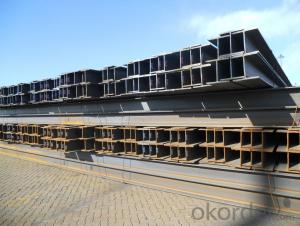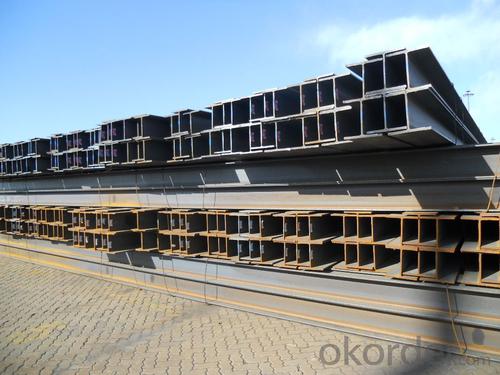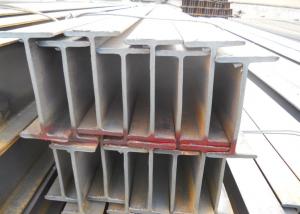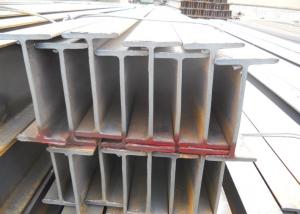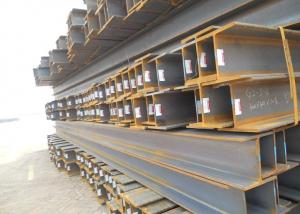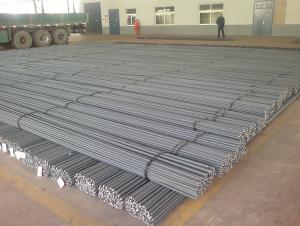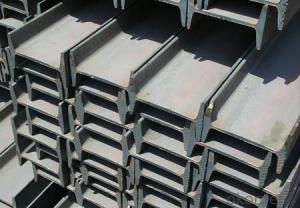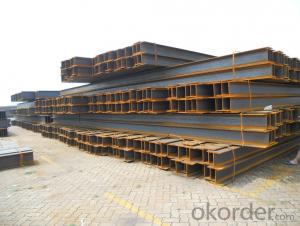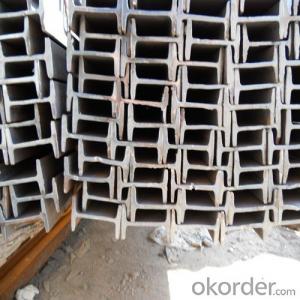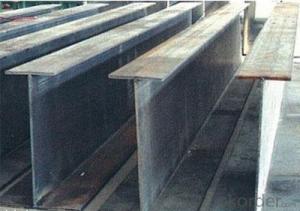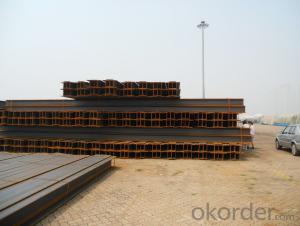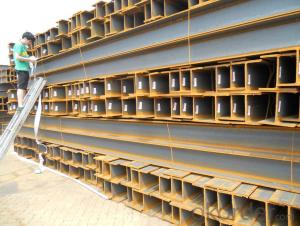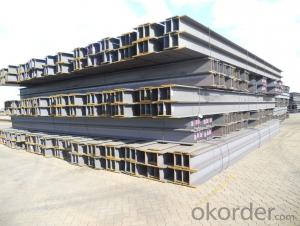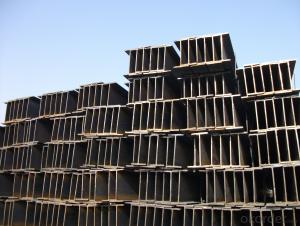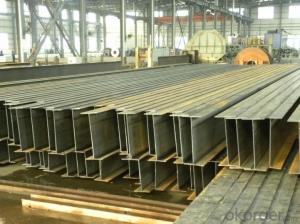JIS Standard SS400 H beams with High Quality 394mm-400mm
- Loading Port:
- China main port
- Payment Terms:
- TT or LC
- Min Order Qty:
- 100 m.t
- Supply Capability:
- 15000 m.t/month
OKorder Service Pledge
OKorder Financial Service
You Might Also Like
Specifications of JIS Standard SS400 H beams with High Quality 394mm-400mm:
1. Standard: JIS 3192
2. Grade: SS400 or Equivalent
3. Length: 10m, 12m as following table
4. Invoicing on theoretical weight or actual weight as customer request
5.Payment: TT or L/C
Size and Mass of JIS Standard SS400 H beams with High Quality 394mm-400mm:
| Size (mm) | Mass (Kg/m) | Size (mm) | Mass (Kg) |
| 400*200*8.0 | 65.4 | 394*398*11.0 | 147 |
| 400*300*10.0 | 105 | |
Packaging & Delivery of JIS Standard SS400 H beams with High Quality 394mm-400mm for Building Structures:
1. Packing: it is nude packed in bundles by steel wire rod
2. Bundle weight: not more than 3.5MT for bulk vessel; less than 3 MT for container load
3. Transportation: the goods are delivered by truck from mill to loading port, the maximum quantity can be loaded is around 40MTs by each truc4. If the order quantity cannot reach the full truck loaded, the transportation cost per ton will be little higher than full load.
4. Delivered by container or bulk vessel
Usage of JIS Standard SS400 H beams with High Quality 394mm-400mm:
(1). for the plant, high-rise building construction
(2). for the bridge, shipment building
(3).for lifting and transportation machinery, equipment manufacturing base building
(4). for the support, foundation pile manufacturing
FAQ:
Q1: Why buy Materials & Equipment from OKorder.com?
A1: All products offered by OKorder.com are carefully selected from China's most reliable manufacturing enterprises. Through its ISO certifications, OKorder.com adheres to the highest standards and a commitment to supply chain safety and customer satisfaction.
Q2: How do we guarantee the quality of our products?
A2: We have established an advanced quality management system which conducts strict quality tests at every step, from raw materials to the final product. At the same time, we provide extensive follow-up service assurances as required.
Q3: How soon can we receive the product after purchase?
A3: Within three days of placing an order, we will arrange production. The shipping date is dependent upon the quatity, how many sizes you want and the plan of production, but is typically 1 month to 2 months days from the beginning of production.
Images of JIS Standard SS400 H beams with High Quality 394mm-400mm:
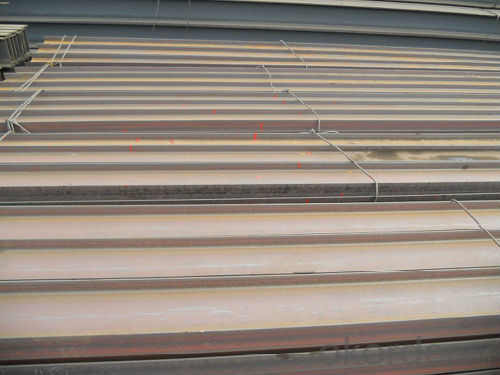
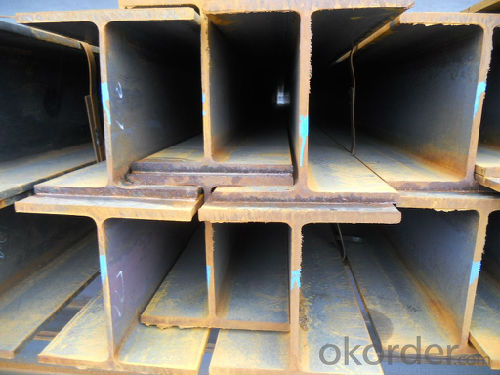
* If you would like to get our price, please inform us the size, standard/material and quantity. Thank you very much for your attention.
- Q: What are the common design considerations for steel H-beams in roofing applications?
- To ensure the structural integrity and safety of a roof, it is important to consider various design factors when using steel H-beams in roofing applications. 1. Load-bearing capacity: The steel H-beams must be designed to withstand the weight of the roof and any additional loads, such as snow, wind, or equipment. It is essential to properly size and space the beams to evenly distribute the loads and prevent any potential failure or collapse. 2. Span and support spacing: Careful consideration should be given to determining the span and support spacing of the steel H-beams based on the specific roof design and anticipated loads. Adequate support is necessary to prevent excessive deflection, sagging, or bending. The spacing between the beams should adhere to engineering standards and codes. 3. Connection details: The connections between the steel H-beams and other structural elements, such as columns or purlins, should be meticulously designed and executed. Strong and secure connections are crucial for proper load transfer and to avoid any disconnection or failure. 4. Fire resistance: Steel H-beams used in roofing applications should be designed to provide sufficient fire resistance. This can be achieved through the use of fire-resistant coatings, insulation materials, or the incorporation of fire-rated materials into the design. 5. Corrosion protection: Steel H-beams are susceptible to corrosion, particularly in outdoor roofing applications where they are exposed to the elements. It is necessary to implement appropriate corrosion protection measures, such as galvanizing or using corrosion-resistant coatings, to prolong the lifespan of the beams and maintain their structural integrity. 6. Thermal expansion and contraction: The design of steel H-beams should account for thermal expansion and contraction caused by temperature variations. This can be achieved by incorporating expansion joints or allowing for appropriate clearance and movement in the design. 7. Sustainability considerations: In modern design, sustainability plays a crucial role. Utilizing recycled steel or incorporating energy-efficient design elements can contribute to the overall sustainability of the roofing system. In conclusion, when designing steel H-beams for roofing applications, it is important to consider load-bearing capacity, span and support spacing, connection details, fire resistance, corrosion protection, thermal expansion and contraction, and sustainability. Addressing these design considerations will ensure that the steel H-beams provide a safe and durable roofing solution.
- Q: How do Steel H-Beams compare in terms of lifespan and durability?
- The exceptional lifespan and durability of steel H-Beams are well-known. These structural members are specifically designed to withstand heavy loads and provide long-lasting support for various construction projects. Unlike wood or concrete, the lifespan of steel H-Beams can be significantly longer. The durability of steel H-Beams can be attributed to several key factors. Firstly, steel itself is inherently strong, with superior tensile strength and resistance to bending and twisting forces. This enables the H-Beams to endure extreme weather conditions, seismic activity, and other external factors that could potentially damage structures over time. Moreover, steel H-Beams are not susceptible to rot, decay, or insect infestations like wooden beams. They also do not degrade or weaken under moisture, a common issue with concrete structures. This makes steel H-Beams highly durable and reliable, ensuring their long-term performance and structural integrity. Additionally, steel H-Beams are resistant to fire, further enhancing their lifespan and durability. Steel has a high melting point and does not contribute fuel to a fire, making it a safer choice for structural elements. This characteristic is particularly important in high-rise buildings or structures where fire protection is crucial. Furthermore, steel H-Beams can be easily inspected for signs of wear or damage. Regular maintenance and inspections can help identify and address any issues promptly, ensuring the continued durability and longevity of these structural members. In conclusion, steel H-Beams possess remarkable lifespan and durability due to their high strength, resistance to environmental factors, and fire resistance. These qualities make them an excellent choice for a wide range of construction projects where longevity and structural integrity are of utmost importance.
- Q: What are the common factors that affect the cost of steel H-beams?
- The cost of steel H-beams can be affected by a multitude of factors. These factors include: 1. Raw material costs: The prices of the raw materials used to produce steel H-beams, such as iron ore and coal, can have a significant impact on the overall cost. Fluctuations in these material prices directly influence production costs and subsequently the selling price of the H-beams. 2. Manufacturing process: The manufacturing process of steel H-beams involves several stages, including melting, casting, rolling, and heat treatment. The efficiency and complexity of these processes can impact the cost. Technological advancements, energy consumption, labor costs, and equipment maintenance expenses all contribute to determining the overall manufacturing cost. 3. Market demand and supply: The demand and supply dynamics of steel H-beams can influence their cost. When demand is high and supply is limited, prices tend to be higher. Conversely, when demand is low and supply is excessive, prices may decrease. Factors such as market conditions, construction projects, and economic conditions all affect the demand and supply of steel H-beams. 4. Transport and logistics: The cost of transporting steel H-beams from the manufacturing facility to the customer's location can impact the final price. Factors such as distance, transportation methods, fuel prices, and handling charges all contribute to the overall cost. Additionally, import duties, taxes, and tariffs imposed by different countries can also affect the cost of steel H-beams. 5. Quality and specifications: The quality and specifications of steel H-beams can influence their cost. Higher-quality materials, superior finishes, and precise dimensions can result in higher prices. Furthermore, specific requirements such as custom sizes, lengths, or special coatings can increase production costs and, subsequently, the selling price. 6. Competition and market conditions: The level of competition in the steel industry can influence the cost of H-beams. Intense competition among manufacturers can lead to price wars and lower prices. Economic factors, global trade policies, and market trends also impact the cost of steel H-beams. It is essential to note that these factors may vary depending on geographic location, industry-specific requirements, and other external factors. As a result, the cost of steel H-beams can fluctuate over time due to changes in any or all of these factors.
- Q: What are the different methods of connecting steel H-beams?
- Connecting steel H-beams in construction projects can be achieved through various methods, depending on specific requirements. Some commonly used methods include: 1. Welding: Popular for connecting steel H-beams, this method involves melting and fusing the beam edges using heat and pressure. Welded connections are strong and permanent, making them ideal for structural steel framing, bridges, and heavy-duty applications. 2. Bolting: Another common method is to secure the beams together using bolts and nuts. Bolted connections are easier to assemble and disassemble compared to welded connections, making them suitable for applications that may require future modifications or repairs. 3. Riveting: Although an older method, riveting is still used in certain applications. It involves using metal rivets to connect the steel H-beams. Riveted connections offer good strength and durability but require specialized equipment and skilled labor for installation. 4. Adhesive bonding: A modern method that utilizes structural adhesives to bond the steel H-beams, adhesive bonding is useful for achieving aesthetics and corrosion resistance. It eliminates the need for visible fasteners and provides some flexibility, allowing for joining of dissimilar materials. 5. Mechanical connectors: These pre-engineered devices offer a quick and efficient way to connect steel H-beams. They typically include plates, bolts, and other components designed for easy installation and high strength. Mechanical connectors are suitable for applications where speed and ease of assembly are crucial. The choice of connection method depends on factors such as load requirements, structural design, project specifications, and available skills and resources. It is recommended to consult a structural engineer or construction professional to determine the most suitable method for connecting steel H-beams in a specific project.
- Q: What are the environmental impacts of using steel H-beams?
- The use of steel H-beams in construction and infrastructure projects has both positive and negative environmental impacts. On the positive side, steel H-beams are highly durable and have a long lifespan, which means they can be reused or recycled when no longer needed. This reduces the demand for new steel production and minimizes the extraction of raw materials, saving energy and reducing greenhouse gas emissions associated with steel manufacturing. However, the production of steel H-beams does have some negative environmental impacts. The manufacturing process involves the extraction of iron ore, which requires significant energy inputs and contributes to air and water pollution. Additionally, the production of steel from iron ore releases large amounts of carbon dioxide, a major greenhouse gas that contributes to climate change. The transportation of steel H-beams from the manufacturing facilities to construction sites also has environmental implications. Shipping and trucking of these heavy materials consume energy and contribute to air pollution, especially if long distances are involved. Furthermore, the construction process itself can have localized environmental impacts. Excavation and site preparation for installing steel H-beams can disrupt natural habitats, leading to habitat loss and fragmentation. Construction activities may also generate noise, dust, and other pollutants that can impact air and water quality and affect nearby ecosystems and communities. Overall, while the use of steel H-beams offers various benefits in terms of durability and recyclability, it is important to consider the environmental impacts associated with their production, transportation, and construction. To mitigate these impacts, sustainable practices such as using recycled steel, optimizing transportation routes, and implementing proper construction site management should be adopted.
- Q: Can steel H-beams be used in educational institutions and schools?
- Yes, steel H-beams can be used in educational institutions and schools. Steel H-beams are commonly used in construction for their strength, durability, and load-bearing capabilities. They are often used in the construction of bridges, high-rise buildings, and other large structures. In educational institutions and schools, steel H-beams can be used for various purposes such as supporting the framework of buildings, constructing gymnasiums and auditoriums, creating outdoor structures like canopies or walkways, and even for educational purposes in engineering or construction-related courses. The use of steel H-beams in educational institutions ensures the safety and stability of the structures, providing a conducive environment for learning and activities.
- Q: What are the dimensions of a steel H-beam?
- The specific design and manufacturer of a steel H-beam can cause variations in its dimensions. Generally, H-beams are distinguished by their height, width, and weight per foot. The vertical distance from the top to the bottom flange defines the height of an H-beam, whereas the horizontal distance between the two flanges represents its width. The weight per foot denotes the quantity of steel utilized in a linear foot of the beam. These dimensions can differ significantly based on the intended purpose and load-bearing prerequisites.
- Q: Can steel H-beams be used in industrial buildings?
- Yes, steel H-beams are commonly used in industrial buildings due to their strength, durability, and versatility. They provide excellent structural support and can withstand heavy loads, making them ideal for large-scale industrial construction projects.
- Q: Can steel H-beams be used in shopping mall construction?
- Shopping malls can indeed utilize steel H-beams. The construction industry frequently employs steel H-beams due to their robustness, endurance, and adaptability. These beams are specifically engineered to endure heavy loads and provide structural reinforcement, which renders them highly suitable for extensive undertakings like shopping malls. The utilization of H-beams in shopping mall construction can encompass an array of purposes, such as bolstering the roof and floors, constructing structural frameworks, and fortifying the overall stability of the edifice. Furthermore, steel H-beams confer various benefits, including their capacity to span significant distances devoid of supplementary support columns, their ability to withstand fire and corrosion, and their recyclability, thus making them an ecologically responsible choice for construction ventures.
- Q: How do steel H-beams compare to other building materials in terms of strength?
- Steel H-beams are widely regarded as one of the strongest building materials available in the construction industry. The unique shape of the H-beam provides exceptional strength and structural integrity, making it highly suitable for various applications. Compared to other building materials such as wood, concrete, or aluminum, steel H-beams offer significant advantages in terms of strength. The high tensile strength of steel allows H-beams to withstand heavy loads and resist bending or warping under pressure, making them ideal for supporting large structures and heavy equipment. Moreover, steel H-beams have a higher strength-to-weight ratio compared to materials like wood or concrete. This means that steel can withstand greater loads while being relatively lighter in weight, making it easier to transport and install. The strength of H-beams also allows for longer spans between support points, reducing the need for additional columns or supports, thus maximizing space utilization in a building. In addition to their superior strength, steel H-beams also offer exceptional durability and longevity. Steel resists corrosion, rot, and pests, which can be common issues with materials like wood. This durability ensures that structures built with steel H-beams can withstand harsh weather conditions and require minimal maintenance over their lifespan. Overall, steel H-beams surpass other building materials in terms of strength, offering unparalleled structural integrity, higher strength-to-weight ratio, and greater durability. These characteristics make them a preferred choice for a wide range of construction projects, from high-rise buildings and bridges to industrial facilities and warehouses.
Send your message to us
JIS Standard SS400 H beams with High Quality 394mm-400mm
- Loading Port:
- China main port
- Payment Terms:
- TT or LC
- Min Order Qty:
- 100 m.t
- Supply Capability:
- 15000 m.t/month
OKorder Service Pledge
OKorder Financial Service
Similar products
Hot products
Hot Searches
Related keywords
